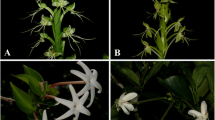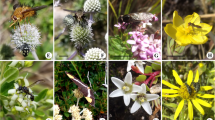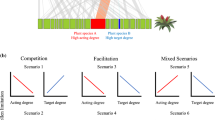Abstract
Floral traits mediate the roles of distinct animals as effective pollinators along a generalization/specialization continuum. Many plant species are visited by different pollinator functional groups and the specific contribution of each group is expected to reflect the set of floral characteristics defined by pollination syndromes. Although considered a highly specialized nectarivorous group, hummingbirds frequently visit flowers lacking apparent specialization to bird pollination. How they contribute to the reproduction of these plants, however, has not been evaluated through field experiments considering multiple non-related plant species simultaneously. Here, we investigated hummingbirds’ contributions to the pollination of ten plant species comprising a gradient of adaptation to bird pollination in the Brazilian rupestrian grasslands. We excluded hummingbirds from flowers and evaluated their relative contribution in comparison to insects (mainly bees) on conspecific/heterospecific pollen deposition and fruit set. Floral traits that are typically associated with bird pollination were associated with increased pollen deposition, but not with fruit set in the presence of hummingbirds. With hummingbirds, conspecific and heterospecific pollen deposition increased in most species, while fruit set increased in four plant species with varying degrees of fit to ornithophily. Our results show that assessing the relative contribution of specific pollinator groups may depend on when this contribution is measured, i.e. pollen deposition or fruit set. Considering fruit set, our results indicate that hummingbirds contributed to plant reproduction independently of the fit to bird pollination syndrome. This emphasizes their importance as under-appreciated generalized pollinators in some communities.




Similar content being viewed by others
References
Aigner PA (2001) Optimality modeling and fitness trade-offs: when should plants become pollinator specialists? Oikos 95:177–184. https://doi.org/10.1034/j.1600-0706.2001.950121.x
Aizen MA, Harder LD (2007) expanding the limits of the pollen-limitation concept: effects of pollen quantity and quality. Ecology 88:271–281. https://doi.org/10.1890/06-1017
Alvares CA, Stape JL, Sentelhas PC et al (2013) Köppen’s climate classification map for Brazil. Meteorol Zeitschrift 22:711–728. https://doi.org/10.1127/0941-2948/2013/0507
Araujo AC, Martín González AM, Sandel B et al (2018) Spatial distance and climate determine modularity in a cross-biomes plant–hummingbird interaction network in Brazil. J Biogeogr 45:1846–1858. https://doi.org/10.1111/jbi.13367
Arceo-Gómez G, Ashman T-L (2011) Heterospecific pollen deposition: does diversity alter the consequences? New Phytol 192:738–746. https://doi.org/10.1111/j.1469-8137.2011.03831.x
Ashman T-L, Arceo-Gómez G (2013) Toward a predictive understanding of the fitness costs of heterospecific pollen receipt and its importance in co-flowering communities. Am J Bot 100:1061–1070. https://doi.org/10.3732/ajb.1200496
Ashman T-L, Alonso C, Parra-Tabla V, Arceo-Gómez G (2020) Pollen on stigmas as proxies of pollinator competition and facilitation: complexities, caveats and future directions. Ann Bot 125:1003–1012. https://doi.org/10.1093/aob/mcaa012
Ballantyne G, Baldock KCR, Rendell L, Willmer PG (2017) Pollinator importance networks illustrate the crucial value of bees in a highly speciose plant community. Sci Rep 7:1–13. https://doi.org/10.1038/s41598-017-08798-x
Bates D, Achler MM, Bolker B, Walker S (2015) Fitting linear mixed-effects models using lme4. J Stat Softw 67:1–48. https://doi.org/10.18637/jss.v067.i01
Bergamo PJ, Rech AR, Brito VLG, Sazima M (2016) Flower colour and visitation rates of Costus arabicus support the ‘bee avoidance’ hypothesis for red-reflecting hummingbird-pollinated flowers. Funct Ecol 30:710–720. https://doi.org/10.1111/1365-2435.12537
Bergamo PJ, Streher NS, Wolowski M, Sazima M (2020) Pollinator-mediated facilitation is associated with floral abundance, trait similarity and enhanced community-level fitness. J Ecol 108:1334–1346. https://doi.org/10.1111/1365-2745.13348
Botes C, Johnson SD, Cowling RM (2009) The birds and the bees: using selective exclusion to identify effective pollinators of African tree aloes. Int J Plant Sci 170:151–156. https://doi.org/10.1086/595291
Camargo MGG, Lunau K, Batalha MA et al (2019) How flower colour signals allure bees and hummingbirds: a community-level test of the bee avoidance hypothesis. New Phytol 222:1112–1122. https://doi.org/10.1111/nph.15594
Castellanos MC, Wilson P, Thomson JD (2004) “Anti-bee” and “pro-bird” changes during the evolution of hummingbird pollination in Penstemon flowers. J Evol Biol 17:876–885. https://doi.org/10.1111/j.1420-9101.2004.00729.x
Chmel K, Ewome FL, Gómez GU et al (2021) Bird pollination syndrome is the plant’s adaptation to ornithophily, but nectarivorous birds are not so selective. Oikos 130:1411–1424. https://doi.org/10.1111/oik.08052
Coetzee A, Spottiswoode CN, Seymour CL (2020) Post-pollination barriers enable coexistence of pollinator-sharing ornithophilous Erica species. J Plant Res. https://doi.org/10.1007/s10265-020-01226-8
Cronk Q, Ojeda I (2008) Bird-pollinated flowers in an evolutionary and molecular context. J Exp Bot 59:715–727. https://doi.org/10.1093/jxb/ern009
Cruden RW (1972) Pollinators in high-elevation ecosystems: relative effectiveness of birds and bees. Science 176:1439–1440. https://doi.org/10.1126/science.176.4042.1439
Dalsgaard B, Maruyama PK, Sonne J et al (2021) The influence of biogeographical and evolutionary histories on morphological trait-matching and resource specialization in mutualistic hummingbird–plant networks. Funct Ecol 35:1120–1133. https://doi.org/10.1111/1365-2435.13784
Dellinger AS (2020) Pollination syndromes in the 21st century: where do we stand and where may we go? New Phytol. https://doi.org/10.1111/nph.16793
Erbar C (2003) Pollen tube transmitting tissue: place of competition of male gametophytes. Int J Plant Sci. https://doi.org/10.1086/377061
Faegri K, Pijl LVD (1979) The principles of pollination ecology, 3rd edn. Pergamon Press, Oxford, UK
Fang Q, Chen Y-Z, Huang S-Q (2012) Generalist passerine pollination of a winter-flowering fruit tree in central China. Ann Bot 109:379–384. https://doi.org/10.1093/aob/mcr293
Fenster CB, Armbruster WS, Wilson P et al (2004) Pollination syndromes and floral specialization. Annu Rev Ecol Evol Syst 35:375–403. https://doi.org/10.1146/annurev.ecolsys.34.011802.132347
Ferreira C, Maruyama PK, Oliveira PE (2016) Convergence beyond flower morphology? Reproductive biology of hummingbird-pollinated plants in the Brazilian Cerrado. Plant Biol 18:316–324. https://doi.org/10.1111/plb.12395
Fox J, Weisberg S (2011) An R companion to applied regression, 2nd edn. Sage, Thousand Oaks
Freitas L (2013) Concepts of pollinator performance: is a simple approach necessary to achieve a standardized terminology? Braz J Bot 36:3–8. https://doi.org/10.1007/s40415-013-0005-6
Goldsmith KM, Goldsmith TH (1982) Sense of smell in the black-Chinned hummingbird. Condor 84:237–238. https://doi.org/10.2307/1367678
Gómez JM (2002) Generalización en las interacciones entre plantas y polinizadores. Rev Chil Hist Nat. https://doi.org/10.4067/S0716-078X2002000100010
Greenland S, Senn SJ, Rothman KJ, Carlin JB, Poole C, Goodman SN, Altman DG (2016) Statistical tests, P values, confidence intervals, and power: a guide to misinterpretations. Eur J Epidemiol 31:337–350. https://doi.org/10.1007/s10654-016-0149-3
Hargreaves AL, Johnson SD, Nol E (2004) Do floral syndromes predict specialization in plant pollination systems? An experimental test in an “ornithophilous” African Protea. Oecologia 140:295–301. https://doi.org/10.1007/s00442-004-1495-5
Kassambara A, Mundt F (2020) Factoextra: extract and visualize the results of multivariate data analyses. R package version 1.0.7. https://CRAN.R-project.org/package=factoextra
King C, Ballantyne G, Willmer PG (2013) Why flower visitation is a poor proxy for pollination: measuring single-visit pollen deposition, with implications for pollination networks and conservation. Methods Ecol Evol 4:811–818. https://doi.org/10.1111/2041-210X.12074
Koski MH, Ison JL, Padilla A et al (2018) Linking pollinator efficiency to patterns of pollen limitation: small bees exploit the plant–pollinator mutualism. Proc R Soc B Biol Sci 285:20180635. https://doi.org/10.1098/rspb.2018.0635
Krauss SL, Phillips RD, Karron JD et al (2017) Novel consequences of bird pollination for plant mating. Trends Plant Sci 22:395–410
Leal RLB, Moreira MM, Pinto AR et al (2020) Temporal changes in the most effective pollinator of a bromeliad pollinated by bees and hummingbirds. PeerJ 8:e8836. https://doi.org/10.7717/peerj.8836
Lehmann LJ, Maruyama PK, Joaquim Bergamo P et al (2019) Relative effectiveness of insects versus hummingbirds as pollinators of Rubiaceae plants across elevation in Dominica, Caribbean. Plant Biol 21:738–744. https://doi.org/10.1111/plb.12976
Lenth R (2020) Emmeans: estimated marginal means, aka least-squares means. R package version 1.7.2. https://CRAN.R-project.org/package=emmeans
Lopes SA, Bergamo PJ, Queiroz SNP, Ollerton J, Santos T, Rech AR (2021) Heterospecific pollen deposition is positively associated with reproductive success in a diverse hummingbird-pollinated plant community. Oikos. https://doi.org/10.1111/oik.08714 (in Press)
Magalhães AFP, Maruyama PK, Tavares LAF, Martins RL (2018) The relative importance of hummingbirds as pollinators in two bromeliads with contrasting floral specializations and breeding systems. Bot J Linn Soc. https://doi.org/10.1093/botlinnean/boy050
Martén-Rodríguez S, Fenster CB, Agnarsson I et al (2010) Evolutionary breakdown of pollination specialization in a Caribbean plant radiation. New Phytol 188:403–417. https://doi.org/10.1111/j.1469-8137.2010.03330.x
Maruyama PK, Custódio LN, Oliveira PE (2012) When hummingbirds are the thieves: visitation effect on the reproduction of neotropical snowbell Styrax ferrugineus Nees and Mart (Styracaceae). Acta Bot Brasilica 26:58–64. https://doi.org/10.1590/S0102-33062012000100007
Maruyama PK, Oliveira GM, Ferreira C et al (2013) Pollination syndromes ignored: importance of non-ornithophilous flowers to neotropical savanna hummingbirds. Naturwissenschaften 100:1061–1068. https://doi.org/10.1007/s00114-013-1111-9
Mayfield M, Waser NM, Price MV (2001) Exploring the “Most Effective Pollinator Principle” with complex flowers: bumblebees and Ipomopsis aggregata. Ann Bot 88:591–596. https://doi.org/10.1006/anbo.2001.1500
Minnaar C, Anderson B, de Jager ML, Karron JD (2019) Plant–pollinator interactions along the pathway to paternity. Ann Bot 123:225–245. https://doi.org/10.1093/aob/mcy167
Muchhala N (2007) Adaptive trade-off in floral morphology mediates specialization for flowers pollinated by bats and hummingbirds. Am Nat 169:494–504. https://doi.org/10.1086/512047
Murcia C, Feinsinger P (1995) Interspecific pollen loss by hummingbirds visiting flower mixtures: effects of floral architecture. Ecology 77:550–560. https://doi.org/10.2307/2265629
Ne’eman G, Jürgens A, Newstrom-Lloyd L et al (2009) A framework for comparing pollinator performance: effectiveness and efficiency. Biol Rev. https://doi.org/10.1111/j.1469-185X.2009.00108.x
Núñez P, Méndez M, López-Rull I (2021) Can Foraging Hummingbirds Use Smell? A test with the Amazilia hummingbird Amazila amazilia. Ardeola. https://doi.org/10.13157/arla.68.2.2021.sc2
Oksanen J, Blanchet FG, Friendly M et al (2019) Vegan: community ecology package. R package version 2.5-7. https://CRAN.R-project.org/package=vegan
Ollerton J (2017) Pollinator diversity: distribution, ecological function, and conservation. Annu Rev Ecol Evol Syst 48(1):353–376. https://doi.org/10.1146/annurev-ecolsys-110316-022919
Ollerton J, Winfree R, Tarrant S (2011) How many flowering plants are pollinated by animals? Oikos 120:321–326. https://doi.org/10.1111/j.1600-0706.2010.18644.x
Ollerton J, Rech AR, Waser NM, Price MV (2015) Using the literature to test pollination syndromes—some methodological cautions. J Pollinat Ecol. https://doi.org/10.26786/1920-7603(2015)17
Queiroz SNDP (2018) Dinâmica temporal e funcional da rede de interações entre plantas e beija-flores no Campo Rupestre da Serra do Espinhaço, Minas Gerais. Dissertation, Universidade Federal dos Vales de Jequitinhonha e Mucuri
R Core Team (2021) R: a language and environment for statistical computing. R Foundation for Statistical Computing, Vienna, Austria. https://www.R-project.org/
Rodrigues L, Rodrigues M (2014) Flowers visited by hummingbirds in the open habitats of the southeastern Brazilian mountaintops: species composition and seasonality. Braz J Biol 74:659–676. https://doi.org/10.1590/bjb.2014.0097
Rosas-Guerrero V, Aguilar R, Martén-Rodríguez S et al (2014) A quantitative review of pollination syndromes: do floral traits predict effective pollinators? Ecol Lett 17:388–400
Santiago-Hernández MH, Martén-Rodríguez S, Lopezaraiza-Mikel M et al (2019) The role of pollination effectiveness on the attributes of interaction networks: from floral visitation to plant fitness. Ecology. https://doi.org/10.1002/ecy.2803
Schmid S, Schmid VS, Zillikens A et al (2011) Bimodal pollination system of the bromeliad Aechmea nudicaulis involving hummingbirds and bees. Plant Biol 13:41–50. https://doi.org/10.1111/j.1438-8677.2010.00348.x
Sihag RC (2018) Some unresolved issues of measuring the efficiency of pollinators: experimentally testing and assessing the predictive power of different methods. Int J Ecol 2018:1–13. https://doi.org/10.1155/2018/3904973
Silveira FAO, Negreiros D, Barbosa NPU et al (2016) Ecology and evolution of plant diversity in the endangered campo rupestre: a neglected conservation priority. Plant Soil 403:129–152
Souza CS, Maruyama PK, Aoki C et al (2018) Temporal variation in plant-pollinator networks from seasonal tropical environments: higher specialization when resources are scarce. J Ecol 106:2409–2420. https://doi.org/10.1111/1365-2745.12978
Stebbins GL (1970) Adaptive radiation of reproductive characteristics in angiosperms, I: pollination mechanisms. Annu Rev Ecol Syst 1:307–326. https://doi.org/10.1146/annurev.es.01.110170.001515
Sun SG, Huang ZH, Chen ZB, Huang SQ (2017) Nectar properties and the role of sunbirds as pollinators of the golden-flowered tea (Camellia petelotii). Am J Bot 104:468–476. https://doi.org/10.3732/ajb.1600428
Waser NM (1978) Interspecific pollen transfer and competition between co-occurring plant species. Oecologia 36:223–236
Waser NM, Fugate ML (1986) Pollen precedence and stigma closure: a mechanism of competition for pollination between Delphinium nelsonii and Ipomopsis aggregata. Oecologia 70:573–577. https://doi.org/10.1007/BF00379906
Waser NM, Price MV (1990) Pollination efficiency and effectiveness or bumble bees and hummingbirds visiting Delphinium nelsonii. Collect Bot 19:9–20. https://doi.org/10.3989/collectbot.1990.v19.114
Waser NM, Price MV (1991) Outcrossing distance effects in Delphinium nelsonii: pollen loads, pollen tubes, and seed set. Ecology 72:171–179. https://doi.org/10.2307/1938912
Waser NM, Chittka L, Price MV et al (1996) Generalization in pollination systems, and why it matters. Ecology 77:1043–1060. https://doi.org/10.2307/2265575
Waser NM, CaraDonna PJ, Price MV (2018) Atypical flowers can be as profitable as typical hummingbird flowers. Am Nat 192:644–653. https://doi.org/10.1086/699836
Wolf LL, Stiles FG, Hainsworth FR (1976) Ecological organization of a tropical, highland hummingbird community. J Anim Ecol 45:349. https://doi.org/10.2307/3879
Zanata TB, Dalsgaard B, Passos FC et al (2017) Global patterns of interaction specialization in bird–flower networks. J Biogeogr 44:1891–1910. https://doi.org/10.1111/jbi.13045
Zych M, Goldstein J, Roguz K, Stpiczyńska M (2013) The most effective pollinator revisited: pollen dynamics in a spring-flowering herb. Arthropod Plant Interact 7:315–322. https://doi.org/10.1007/s11829-013-9246-3
Acknowledgements
We thank Nick Waser, Jeff Ollerton, two anonymous reviewers and the editor Susan Whitehead for constructive suggestions that greatly improved the quality of the manuscript. We thank Steffani Queiroz and Sabrina Lopez for sharing the plant data used in this study. MDA is grateful to the Fundação de Amparo à Pesquisa do Estado de Minas Gerais (APQ-00756-19) and to Coordenação de Aperfeiçoamento de Pessoal de Nível Superior—Brasil (process no. 88887.626004/2021-00). GJB is grateful to the Coordenação de Aperfeiçoamento de Pessoal de Nível Superior—Brasil (process no. 88887.352134/2019-00) and to Conselho Nacional de Desenvolvimento Científico e Tecnológico (process no. 165548/2020-7). PKM and ARR are grateful to the Fundação de Amparo à Pesquisa do Estado de Minas Gerais (RED-00253-16 and APQ-00932-21) and Conselho Nacional de Desenvolvimento Científico e Tecnológico (process no. 423939/2021-1 and 400904/2019-5). We also thank Carlos Coquinho for sharing a Palicourea rigida photograph.
Author information
Authors and Affiliations
Contributions
MDA, CSA and ARR conceived the ideas and designed the methodology; MDA and GJB collected the data; MDA, PKM and GJB analyzed the data; MDA wrote the first draft of the manuscript with ARR supervision. All authors contributed critically to the drafts and gave final approval for publication.
Corresponding author
Ethics declarations
Conflict of interest
The authors declare that they have no conflict of interest.
Additional information
Communicated by Susan Whitehead.
The importance of pollinator sharing in generalized systems. Unexpected interactions may contribute to plant reproduction.
Supplementary Information
Below is the link to the electronic supplementary material.
Rights and permissions
About this article
Cite this article
Amorim, M.D., Maruyama, P.K., Baronio, G.J. et al. Hummingbird contribution to plant reproduction in the rupestrian grasslands is not defined by pollination syndrome. Oecologia 199, 1–12 (2022). https://doi.org/10.1007/s00442-021-05103-6
Received:
Accepted:
Published:
Issue Date:
DOI: https://doi.org/10.1007/s00442-021-05103-6




